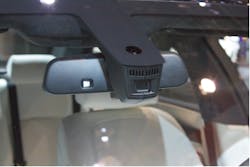As we continue our series exploring the different Advanced Driver Assistance Systems, we have looked at automatic emergency braking (AEB), and long-range radar typically used in adaptive cruise control (ACC). Today we will take a look at the forward-facing camera and the multiple roles it plays in ADAS.
The forward-facing camera is typically found at the top of the middle of the windshield. It is either mounted on or near the rearview mirror, and in some cases is built right into the rearview mirror. This is a convenient, out-of-the-way spot that also allows the camera to “see” clearly without being affected by the elements of the weather. While most OEMs only use one camera, there is always an exception, as one vehicle makers utilizes two forward-facing cameras.
The camera is often utilized in the ACC system along with the long-range radar we covered last time. Its function is to help detect and gauge vehicle distance. It often works in concert with the radar, communicating back and forth to confirm detection before initiating a change in speed or an application of the brakes.
Similarly, the camera works in conjunction with the long-range radar in another ADAS we have discussed, the AEB system. Just like the ACC, the camera supplements the radar. This allows for a more accurate and sensitive system with fewer false alarms and more precise vehicle intervention.
Helping to control the distance of the vehicle from objects ahead is not all the forward-facing camera can do. It has several additional roles as well. One of those duties is to provide input to the lane departure warning and lane keep systems. These are typically found together, as one is often the precursor to the other. This means that the system will produce one or more warnings of an eminent unintended lane departure before intervening and correcting the vehicle to the center of the lane. The camera “sees” or identifies lane markings and determines if the vehicle is adequately within those markings.
Vehicles that are equipped with traffic sign recognition will often utilize the forward-facing camera as well, although some have a dedicated camera for just this purpose. With this system the camera can recognize common road signs such as speed limit and do not enter signs. They will then display the recognized sign on the instrument cluster. In some cases, the system will provide a haptic (vibrating) or audible warning depending upon the sign. For example, if the driver is not following the posted speed limit.
Often times the forward-facing camera will also be the input for controlling the automat high beam lighting system. It does this by sensing the light levels in front of the vehicle and detecting vehicles. It then turns the high beams on and off accordingly.
The camera is a very sensitive piece of equipment and typically requires calibration if removed/installed or replaced. In some cases, a calibration is required if an airbag deployment occurred. It is almost a guarantee that the camera will need to be calibrated after a windshield replacement, but not always. It is important to look in the vehicle-specific body repair manual (BRM) or service manual to determine what events will require a camera calibration to be performed.
In regard to the windshield, it should be obvious that a dirty or snow-covered windshield in the area of the field of vision of the camera will inhibit or prevent the camera from performing as it should. To help avoid issues with the camera being able to see, often times there will be a heating device that will help to remove condensation, snow and ice from the windshield area in front of the camera.
However, for the camera to function properly, there is more to it than that. A windshield that has cracks, chips or other damage in the field of vision can also impede the function of the camera, potentially causing multiple ADAS to not work properly. Many OEMs prohibit repairs to the windshield in front of the camera’s field of view. In addition, the use of the correct windshield and proper installation following vehicle-specific OEM procedures is imperative to ensuring the camera functions properly.
Similar to the long-range radar, the forward-facing camera typically has calibration procedures. Calibration is, in simple terms, the realigning of the camera orientation to where it is supposed to be. The idea is simple, but the process can be more complex. Factoring in that there are multiple ways that the camera can be calibrated, and that even within the same OEM, different vehicles may have different calibration procedures, understanding these differences and variables in how a camera is calibrated is essential. There are two main types of calibration, each with their own varied techniques depending upon the OEM and/or specific vehicle. These are static and dynamic calibrations.
Static calibration, as the name implies, is done with the vehicle stationary. Within a static calibration, the camera may need to be accessed by removing a trim piece that surrounds it. This is because some procedures require the manual alignment of the camera by turning an adjusting screw and using a bubble level, angle gauge, or other similar device to measure if the camera is level or within a specified parameter.
Other static calibration procedures will not require this manual adjustment and will be calibrated by using a scan tool and special tools such as targets and stands. With the use of the scan tool, the camera is activated and views the precisely placed targets to determine and calibrate the correct sensing area of the camera.
Dynamic calibration is performed with the vehicle in motion. Again, the exact procedure will vary across OEMs and models. Regardless, the procedure will have specific parameters that the vehicle must be operated at. These may include driving at a specified speed, avoiding curved roads, following one or more vehicles, clearly marked lanes, and may even require an environment with stationary objects on the side of the road. Following the parameters given will not only help ensure the calibration is performed correctly, it will likely reduce the time needed to successfully complete the calibration. Dynamic calibrations typically will require the use of a scan tool and may require two technicians; one to drive the vehicle and one to operate the scan tool. Even if the procedure does not specify, erroring on the side of safety by utilizing two technicians as needed is good practice. One point to mention in regard to replacing forward-facing cameras is that certain OEMs will require programming or coding when a camera is replaced.
One additional point to clarify is that a dynamic calibration is not the same as a test drive. If the vehicle requires a dynamic calibration, the test drive should not be done simultaneously. This is because the conditions for a test drive are not the same as the conditions in which a dynamic calibration is performed. A test drive should be performed after all static and dynamic calibrations are completed, often as a final step before the vehicle is delivered to the customer.
When working with ADAS, it is vital to understand and follow vehicle specific procedures not only for programming and calibration details, but for special tools and equipment needed as well.
For more information on I-CAR ADAS courses, news, webinars, podcasts and more, check out https://info.i-car.com/adas




